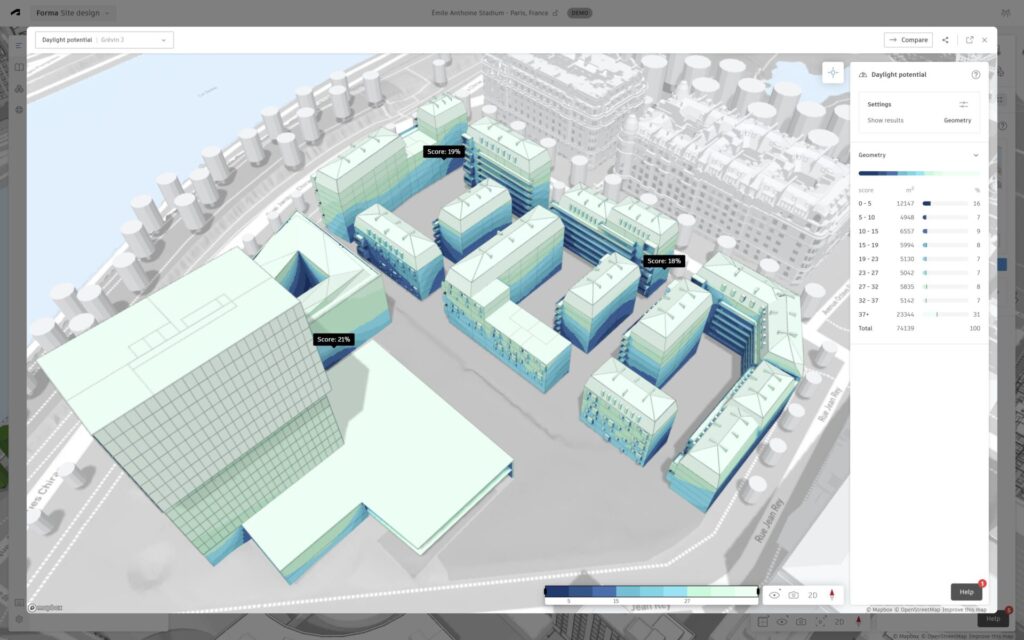This article was updated on October 2025 with the latest in daylight potential analysis.

People residing in major countries spend over 90% of their lives indoors, within buildings that receive limited daylight. Research highlighting the benefits of daylight on health, happiness, and productivity, suggests that we should be more concerned about the impact of too little daylight in our homes and offices. Many countries have specific daylight requirements for planning applications. Furthermore, it’s a main consideration of sustainability certifications such as LEED and BREEAM.
Yet, despite widespread recognition of its importance, for many architects and urban planners, it is a time-consuming process to understand daylight on their sites, often requiring complex software and technical expertise.
Introducing Forma Site Design’s daylight potential analysis: enabling you to visualize daylight potential in context with the surrounding buildings and environment, in minutes from day one. Meaning you can make fast, smart decisions that improve building performance and enhance daylight on your site.
Autodesk Forma’s daylight potential analysis
Daylight potential analysis simplifies the process of meeting daylight requirements, providing architects and urban planners with quick, valuable insights into the daylight performance of their projects. The analysis’s result provides a Sky Component score that can be used as the base to identify areas with less-than-optimal daylight, as well as those sections where it might be impossible to achieve reasonable daylight conditions. This function also highlights façade areas with inappropriate levels of light that could be modified to improve housing quality or be allocated to other functions.
Forma’s analysis function uses the CIE Standard Overcast Sky Model to predict the light conditions on building surfaces. The Overcast Sky Model represents a heavily clouded day in September and is commonly used in daylight simulations. Considered a conservative representation of light conditions, this model is relevant independent of changes due to the sun and other weather conditions.
Running the analysis
To access the analysis in Forma, navigate to the Daylight Potential option in the Analyze menu on the right panel. Open the Analysis Area Selection menu at the top of the right panel and continue to select one or more site limits or zones. This will define the area where the daylight potential analysis will be computed.

How to interpret the analysis results
The result of this analysis, shown as a percentage score, is a Sky Component measure of how much light reaches the facades from the sky. For different points on a building, the Sky Component score indicates how much light would shine through a window placed at those specific points. For daylight falling on vertical facades, the sky component is referred to as Vertical Sky Component (VSC).
The daylight conditions are usually regulated by a component called Daylight Factor, which is computed based on the daylight reaching interior spaces through windows and room layouts in the presence of an overcast sky. Given the inter-relationship between VSC and the Daylight Factor, VSC can also be used as a predictor for daylight conditions.
The table below shows expected daylight conditions for different ranges of VSC scores.
Vertical Sky Component (VSC) default thresholds – For points on facades | Daylight conditions |
| VSC ≥ 27% | Conventional window designs are usually satisfactory |
| 15% < VSC < 27% | Larger windows/changes are usually needed in the layout |
| 5% < VSC < 15% | Difficult to provide adequate daylight |
| VSC < 5% | Achieving reasonable daylight is often impossible |
Analysis results are divided into color bins using the thresholds from this table. For the darkest areas achieving reasonable daylight is often impossible, while for the lightest areas daylight conditions are usually satisfactory. The maximum score for VSC is around 40%. As for non-vertical faces, the Sky Component scores can go all the way up to 100%.
Additionally, use the inspect tool to see the Sky Component values for specific points on the building. To enable the Inspect Tool, navigate to the icon on the top right corner of the 3D canvas. You can then proceed to select specific points of interest to be examined.

What is the difference between Forma’s sun hours analysis and daylight potential analysis?
The daylight potential analysis feature works on the basis of how much of the day sky can be seen through the windows and does not take into consideration the sunlight or sun rays. On the other hand, the sun hours analysis works by measuring the number of sunlight hours at different points on the ground and on the building’s façade. If you are building too dense, or have balconies or overhangs above the window, this will negatively affect the amount of daylight in the apartment and can be analyzed and rectified using Forma’s daylight potential analysis.
Using Forma’s daylight potential analysis, you can quickly explore a large number of options, and enhance both business and environmental outcomes. Leveraging the effective combination of data-driven insights and compelling visuals, you can make informed decisions to improve building performance, and get all the stakeholders on board earlier. It’s a huge boost for simplifying the process of designing healthy and high-quality living spaces.
Many of our users are already benefiting from the daylight potential analysis capability of Forma. Learn how the global engineering firm, Skanska, saved time, and created a vibrant new neighbourhood by using Forma’s predictive analytics and cloud collaboration capabilities.